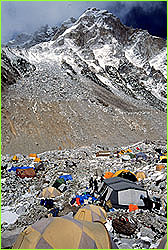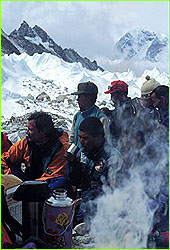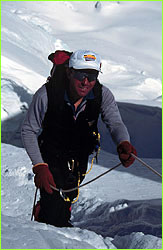 |
 |
 |
Going Higher: Up to Camp II by Liesl Clark  At 4:30 a.m. a low deep hiss hits the senses before cognition
arrives. It's a sound like no other that seeps into your dreams until you
awaken to reality; you're at Everest Base Camp. Someone is already in the
kitchen tent heating up water for morning tea. Throughout the day the hiss of
the kerosene stove will continue—it's our lifeline of fuel and fire to heat
water and food. Without it, we'd be unable to survive up here at 17,600 feet.
Ice crystals cling to the roofs of our tents, the remains of frozen breaths from
a long night of sleep in zero-degree temperatures.
At 4:30 a.m. a low deep hiss hits the senses before cognition
arrives. It's a sound like no other that seeps into your dreams until you
awaken to reality; you're at Everest Base Camp. Someone is already in the
kitchen tent heating up water for morning tea. Throughout the day the hiss of
the kerosene stove will continue—it's our lifeline of fuel and fire to heat
water and food. Without it, we'd be unable to survive up here at 17,600 feet.
Ice crystals cling to the roofs of our tents, the remains of frozen breaths from
a long night of sleep in zero-degree temperatures. Today David Breashears, Jangbu Sherpa, Pete Athans (our climbing digital cameraman), and our team's three climbing Sherpas are all heading up the Icefall to Camp I, and then on to Camp II. Ed Viesturs and David Carter are at Camp II, having spent several nights up there already, for acclimatization.  I throw on several layers of clothing before unzipping the tent door to crawl
out into the early morning freeze. There's no movement outside, the stars are
out, and the peaks stand silently, waiting for the first rays of sun to hit
them. An early morning stumble to the kitchen tent demands a concerted effort
in coordination, to avoid tripping over the many shaped stones that layer the
ice of the glacier.
I throw on several layers of clothing before unzipping the tent door to crawl
out into the early morning freeze. There's no movement outside, the stars are
out, and the peaks stand silently, waiting for the first rays of sun to hit
them. An early morning stumble to the kitchen tent demands a concerted effort
in coordination, to avoid tripping over the many shaped stones that layer the
ice of the glacier. You have to duck down to enter through the hanging tarp "door" of the kitchen tent, and a cup of milk tea is handed to you the moment you step inside. David, Pete, and Jangbu cradle warm cups in their hands as they sit on the stone seats that make up the kitchen tent's walls. A blue tarp acts as the ceiling for the kitchen's stone structure, which is lined on one side with cans of vegetables, sugar, and powdered milk. In the center of the tent is a stone table where the two kerosene stoves hiss all day long.  Why do the climbers have to leave so early for a trip through the Icefall? "You
want to get in there before the sun hits," explains David. "It not only gets so hot up there you
can barely move, but with the sun's heat there's the perception that the
Icefall becomes less stable and large pieces of glacial ice can come tumbling
down on top of you." Twice already, ladders have come down on
the route through the Icefall, putting a stop to all traffic between Base Camp
and Camp I. "Generally when that happens, it means the ice that the bottom
ladder was set on just gave way," interjects Pete Athans. "And, it just means
time for the ladders to be re-set again."
Why do the climbers have to leave so early for a trip through the Icefall? "You
want to get in there before the sun hits," explains David. "It not only gets so hot up there you
can barely move, but with the sun's heat there's the perception that the
Icefall becomes less stable and large pieces of glacial ice can come tumbling
down on top of you." Twice already, ladders have come down on
the route through the Icefall, putting a stop to all traffic between Base Camp
and Camp I. "Generally when that happens, it means the ice that the bottom
ladder was set on just gave way," interjects Pete Athans. "And, it just means
time for the ladders to be re-set again."Continue: The Magic Hour Lost on Everest | High Exposure | Climb | History & Culture | Earth, Wind, & Ice E-mail | Previous Expeditions | Resources | Site Map | Everest Home Editor's Picks | Previous Sites | Join Us/E-mail | TV/Web Schedule About NOVA | Teachers | Site Map | Shop | Jobs | Search | To print PBS Online | NOVA Online | WGBH © | Updated November 2000 |